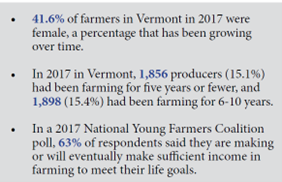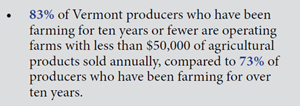Editor’s note: This brief is part of the Vermont Agriculture & Food System Plan 2021-2030 submitted to the legislature in January 2021. To read the full plan, please go to
Lead Author: Sam Smith, Intervale Center
Contributing Authors: S’ra Desantis, UVM | Ben Waterman, UVM Extension; Jon Ramsay, Center for an
Agricultural Economy; Taylor Hutchison, Young Farmers Coalition; Jenn Miller, NOFA-VT.
What’s At Stake?
Vermont is facing a dramatic shift in the agricultural sector due to economic and demographic changes. The key to the maintenance and development of the farms that form the backbone of our rural communities is to support the next generation of farmers. These new and beginning farmers face a number of challenges including shifting markets and production models, increased risk due to climate change, and barriers to accessing land. The types of support that are critical to their success include assistance in identifying and accessing suitable land, development of strong management
and production capacity, supportive policies around markets, and access to capital. The new generation of farmers needs this type of support to create viable farm businesses, to keep the Vermont landscape in active agricultural use, and to preserve the character of our rural communities.
Current Conditions
State and national trends show an aging farmer population, increased land pressure for non-agricultural uses, and a rapidly changing marketplace for agricultural goods. Within Vermont, the conventional dairy sector, which has long been the backbone of the state’s agricultural economy, is struggling to maintain viability (see Dairy brief).

The current and future generation of Vermont farmers face a number of significant challenges, including limited markets for local products, increasing land values, increasing production uncertainties due to climate change, and evolving agricultural business models. In addition, starting and growing a farm operation has become increasingly capital intensive in terms of both operating expenses and land purchase. All of these factors combine to make for a very challenging environment for farmers to be successful.
As agricultural production practices and markets shift, accessing land remains one of the most important factors in the success of new and beginning farmers. The decline in the number of dairy farms in the state and adoption of diversified farming models is changing the types of farmland and infrastructure that are suitable for viable farm businesses. Land conservation initiatives like the
Option to Purchase at Agricultural Value (OPAV) and the Farmland Access Program at the Vermont Land Trust promote increased affordability and access to farmland to some buyers. These projects are now paired with robust business planning and technical assistance to improve the potential success of the farmer. Although this process improves the potential viability of a new farm, the capacity to support these complex projects is still very limited due to funding constraints.
Despite the challenges faced by new and beginning farmers in Vermont, there are reasons for optimism within the agricultural sector. Vermont’s new and beginning farmers are enthusiastic, resilient, and well supported in approaching farming as a business. They are supported by statewide service providers to grow their management and production capacity toward making
sustainable business decisions.
New and Beginning Farmers

Current Conditions
While agriculture in Vermont faces a number of significant challenges, there are still large numbers of new and beginning farmers eager to make farming their life-long livelihood. These diverse and enthusiastic agrarians are learning from other farmers in their community and through business and
technical assistance from various service providers, but they face many structural challenges to achieving successful, viable businesses. These challenges include access to capital, access to markets, and the decline of the dairy sector and associated agricultural support services (e.g., large animal veterinarians).
Bottlenecks & Gaps
• New farmers can face saturation in local markets, insufficient price points, and regional markets that
are difficult to access.
• Lenders may not understand new farm models, making it difficult for farmers to access capital.
• New farmers may be impacted by racial prejudice, student loan debt, lack of off-farm jobs for a
partner, and unaffordable health insurance, housing, and child-care.
• Some agricultural support services (e.g., feed dealers) may not have enough farm activity to
support their businesses, thus impacting other farms.
Opportunities
• Enthusiasm for socially and environmentally conscious investment can be harnessed to develop new and creative financing tools for operations and land purchase.
• Individuals or groups of producers can develop marketing mechanisms for niche or higher margin product lines.
• Access to regional metropolitan markets through improved distribution and marketing infrastructure remains a potential area of improvement.
Farmland Access
Current Conditions

As farmer demographics change and agricultural business models shift, access to suitable and affordable farmland is a major concern for the next generation of new and beginning farmers. Using services like Vermont Land Link, a farmland-specific listing and linking service, farmers can identify and assess potential land opportunities for lease or purchase. The Vermont Land Trust’s Farmland Access Program is now routinely paired with robust production and financial technical assistance from the Intervale Center, UVM Extension, or other service providers to help new farmers succeed.
Bottlenecks & Gaps
• Vermont land costs are high relative to the potential for income generation from agricultural activities.
• Exiting farmers often stay on their land for financial or sentimental reasons. This can force beginning farmers into non-favorable land agreements or struggles to find suitable housing.
• Current farm business models often require less land or different infrastructure than the parcels that are available.
• Potential farm successors do not always have the skillset or financial position to assume management or ownership of larger existing farm operations.
Opportunities
• Many retiring or exiting farmers do not have identified successors, leading to opportunities for new and beginning farmers to access land.
• There could be better utilization of farmland owned by non-farming landowners through lease or eventual purchase.
• New or novel land use models are being developed, including multiple farm operations co-locating on a single parcel or even shared ownership models.
• The Farmland Access Program and accompanying farm business development technical assistance to accelerate farmland access can be expanded.
• Continue to explore the use of creative landholding and financing mechanisms to assist farmers in land access and purchase.
Supporting Farm Businesses

Current Conditions
Farming today requires a diverse and refined skill-set. As access to viable commodity markets become more difficult, farmers must focus on business management and marketing. They are supported in developing management capacity by business advisors from the Farm Viability Network and production technical assistance from the University of Vermont and producer networks.
Bottlenecks & Gaps
• New markets and production models require a much higher level of business management skills from farmers to communicate with customers and manage day-to-day operations.
• As production models shift away from established commodity models, there is an increased need for applied research and education around alternative products and markets.
• Farmers with limited capital have difficulty accessing and purchasing land.
Opportunities
• If continued, financial support for, and development of, the Farm Viability Network and increased business assistance for farmers will build their planning, decision-making, and management capacity (see Business & Technical Assistance brief).
• Targeted applied research would improve production and financial knowledge in specific sectors, including grass-fed beef, maple, vegetable, and diversified production.
• Support for producer organizations would increase education and marketing efforts to improve access to markets. Development of informal farmer networks through cohort-based support can strengthen producer communities as they take risks and try new enterprises.
Summary
Supporting new and beginning farmers is essential to the long-term success of Vermont’s agricultural sector and the culture of our rural communities. Expanding existing business and technical assistance along with the right match of capital can improve farmers’ ability to access suitable, high-quality farmland and ensure they develop successful farm businesses.
These efforts can be paired with policy mechanisms, alternative financing mechanisms, and enriched market research opportunities to incentivize farm business development.
Recommendations
• Expand financial support for Vermont Land Trust’s land conservation and transition efforts, including buy-lease sell opportunities, Farmland Access Program, and land conservation.
• Support regional market development efforts, especially entrepreneur-driven aggregation and distribution activities. Develop co-marketing enterprises that allow for local sales associated with a specific farm brand while also providing aggregated regional market access.
• Increase funding support for Vermont Housing and Conservation Board Farm & Forest Viability Program and UVM Extension’s production technical assistance for farmers. This should include increasing funding for one-on-one technical assistance, bolstering producer associations, and increasing directed applied research and education.
• Increase the development of non-traditional land access and financing models, including collaborative/co-located farms, local low-cost financing options, and programming for underserved populations.
• Increase education and advocacy efforts to inform state and federal programs about new and emerging business models. Involve farmers and business assistance providers in the development and implementation of state and federal regulatory, conservation, and financing programs.

